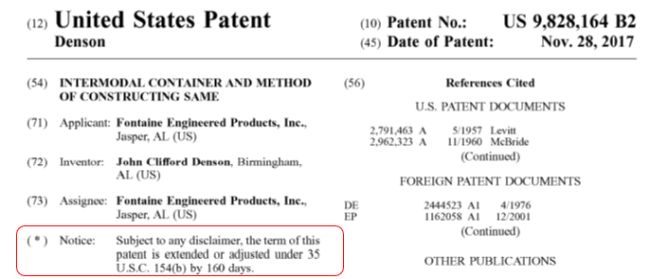An overarching feature of patents is that patents are an asset, but patents are a kind of wasting asset. Issued patents have a finite life span determined by the laws of the issuing country, and eventually expire. This post explains when patent owners can expect a patent to expire.
The limited life of patents comports with the provision of patents in the US Constitution (Art. I, §8, cl. 8: "To promote the Progress of Science and useful Arts, by securing for limited Times to Authors and Inventors the exclusive Right to their respective Writings and Discoveries"; emphasis added). I often like to point out that patents were a cutting-edge social policy in the 18th century, and my view is that the strong US patent system enormously contributed to the great technological advances in the 19th and 20th centuries and continue today. Patents are just as relevant as ever.
A Little History: In the US, patent terms were set at 17 years from the date of grant in 1861. This rule ended on June 8, 1995, when patent terms were brought into compliance with the Trade-Related Aspects of Intellectual Property Rights (TRIPS) agreement in the Uruguay Round of the General Agreement on Tariffs and Trade (GATT) of 1994 (TRIPS Agreement Art. 33). After the TRIPS agreement, Congress amended 35 U.S.C. § 154 so that patent applications filed on or after June 8, 1995 nominally have a life of 20 years from the non-provisional filing date (but some extensions may be available). Countries in Europe had this 20-year rule previous to the TRIPS agreement.
An issue with the former 17-year rule is that patent applicants were fond of "gaming" the system, and keeping patent applications in prosecution for extended periods, which in effect allowed applicants to extend the term of a patent. So, an applicant could keep a patent in prosecution for say, 10 years, and when the applicant finally allowed it to issue, the patent would expire 27 years from the original filing date. Patent applicants could utilize various procedural methods to delay action and keep a case alive without paying the issue fees and effectively extend the life of a patent. In fact, there may even be patent applications in the USPTO today, almost 28 years after 1995, that were filed under the pre-GATT provisions and will expire 17 years from grant if they ever issue.
General Rule: But for the rest of us, the general rule in essentially every country in the world, and certainly every economically important country (since all major economies are members of the WTO that administers TRIPS) is that patents expire 20 years from the earliest non-provisional patent application filing date.
What is a non-provisional patent application filing date? For US patent applicants, that is the date of filing the first US non-provisional patent application (under 35 U.S.C. §111(a)), also termed a utility patent application, or a PCT International Patent Application. Other countries may have different terminology, like a "standard" or "ordinary" patent that is equivalent to a US utility patent, that if granted, will expire 20 years from the first filing date.
Provisional Patent Applications: Even prior to the 1994 TRIPS Agreement, the Paris Agreement (1883, amended several times, most recently in 1979) provided for a right of priority for patent applications of 12 months (Paris Convention Art. 4). Originally, this applied to the idea that if you filed a patent application, you had 12 months to file the patent application in another country and claim priority to the first patent application. The problem was that in a country where the patent expiration date is fixed to the filing date, an applicant would get a longer patent term elsewhere than in the applicant's home country.
To make this process fairer, provisional patent applications were created to establish a right of priority under the Paris Convention. Provisional patent applications were established in the U.S. with the law that went into effect on June 8, 1995 (35 U.S.C. §111(b)). At this time, all major countries have provisional patent applications. They all work the same. The general idea is that a patent applicant files a paper at a national patent office with an invention disclosure. The filing is called a "provisional patent application." Provisional patent applications are allowed to be informal. There are no formatting requirements, and claims are not required (unlike regular patent applications). The applicant then has 12 months to file a patent application anywhere in the world that claims priority to the provisional. It is important to note that provisional patent applications are not examined for novelty and non-obviousness and never issue – there is no such thing as a granted provisional patent application.
An important feature is that a provisional patent application in effect gives patent applicants an extra year of patent life at the front end. Here is a graphic representation with exemplary dates:

So the total patent life is 21 years from the first provisional filing date. For a discussion of provisional patent applications in more detail, see our post on this topic. There is a lot of patent strategy that goes into provisional and non-provisional patent applications, so non-experts should work with a professional when filing provisionals or any patent application.
Patent Term Extensions: in the US, there are two patent term extensions that we can mention.
§154(b) Patent Term Extensions: when the 1995 law change went into effect, patent applicants were concerned that delays in patent office responses would have a negative impact on patent life. One way of looking at the 1995 law change was that patent applicants had a three-year allowance for patent prosecution and would then get a 17-year patent life, similar to the old rules. But patent office delays are all too common and pendencies longer than three years were (and are still) common through no fault of the patent applicant. Therefore, 35 U.S.C. §154(b) was enacted, called a "Guarantee of No More Than 3-Year Application Pendency" with a formula for calculating a patent term extension based on delays in patent office responses. The period of extension is found, if applicable, in the bibliographic data on the front page of published patent applications. For example, this patent received a 160-day extension:

Section 154(b) extensions are fairly common.
Another patent term extension is under 35 U.S.C. §156 which was created in 1984 in the Hatch-Waxman Act, which is intended to extend a patent term for up to five years for regulatory delays for patents on a product, such as a drug substance, that requires regulatory approval. These extensions are not listed on the front page of the patent, so if you think such an extension may apply, you will need to contact a patent attorney to determine if the extension is applicable. For drugs, §156 extensions are not typically approved until shortly before the drug is approved
Shortening Patent Terms: there are situations where a patent owner is obligated to shorten a patent term or elects voluntarily to do so. This is done through a disclaimer.
Maintenance Fees: The last topic is maintenance fees. Merely because you own an issued patent, the owner cannot simply forget about it. In the United States, "maintenance fees" are due at 3.5, 7.5, and 11.5 years after the date of grant. Failure to pay maintenance fees will cause the patent to lapse and become unenforceable. In many other countries, annual fees are required to maintain a patent in force. In some countries, annual fees are required even before grant. Our firm uses a service that sends out reminders and manages these payments.
Conclusion: In most cases, a patent term is 20-years from the non-provisional patent filing date. Use of a provisional patent application can add one-year to patent life at the front end. Maintenance fees or annual fees are generally required to keep a patent alive, in some cases even before grant. Please contact us with any questions, or for more information to address your specific needs.
The content of this article is intended to provide a general guide to the subject matter. Specialist advice should be sought about your specific circumstances.

